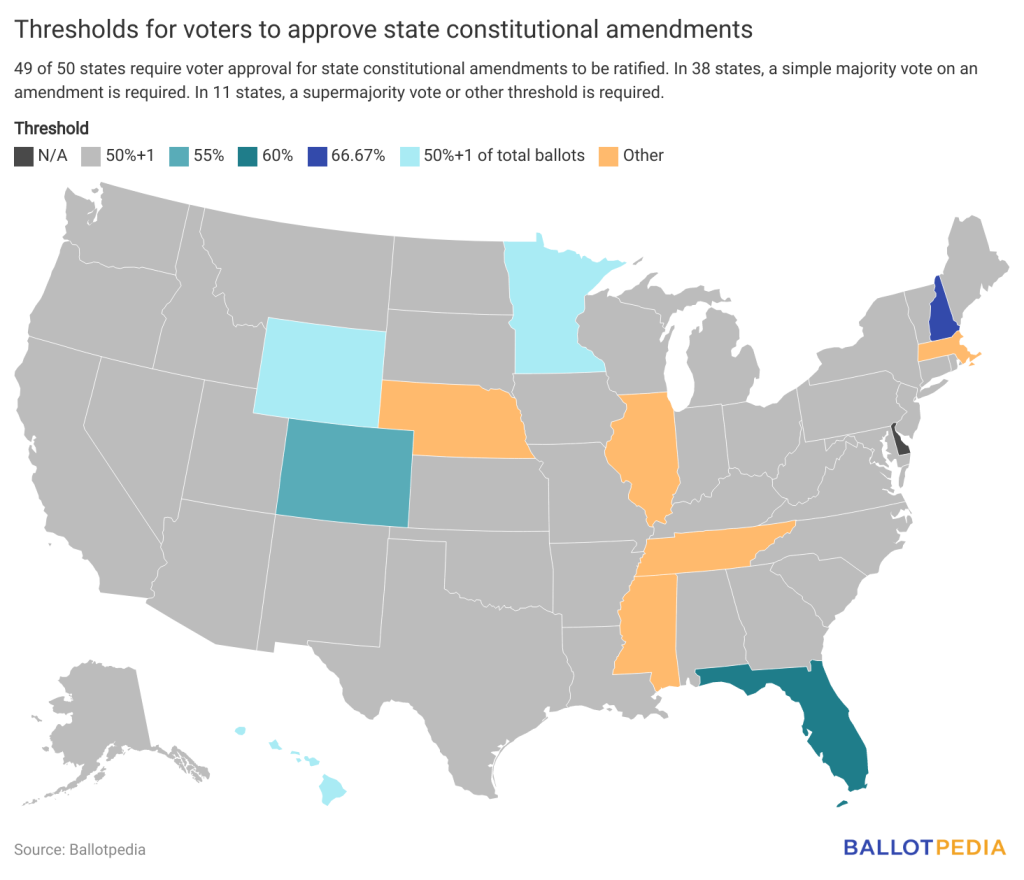On Aug. 8, voters in Ohio will approve or reject Issue 1, which would make three changes to the laws governing citizen-initiated constitutional amendments. With the commencement of early voting yesterday, we took the opportunity to provide an overview of Issue 1, which you can read here.
In this article, we delve into one specific provision of Issue 1—the 60% vote requirement for constitutional amendments—and the history of supermajority requirements for ballot measures across the states. Tomorrow, we will publish an article exploring a second provision of Issue 1—the proposed change to the signature distribution requirement for citizen-initiated constitutional amendments.
Issue 1 would require a 60% vote on future constitutional amendments, including those that could appear on the ballot in Nov. 2023, such as an abortion-related constitutional amendment. Currently, a simple majority (50%+1) vote is required for voters to approve constitutional amendments in Ohio.
Voters decide on constitutional amendments in 49 of 50 states. In these states, legislatures are required to seek voter approval to amend their state constitutions. Delaware is the one state where voter approval is not required. Eleven (11) states require a supermajority vote or other election vote threshold for constitutional amendments.
Issue 1 would make Ohio, tied with Florida, the state with the highest voter approval requirement to pass citizen-initiated constitutional amendments. Voters in Florida approved a ballot measure, Amendment 3, to require a 60% vote in 2006. New Hampshire, which does not have citizen-initiated constitutional amendments, has the highest vote requirement at two-thirds (66.67%). New Hampshire has had a two-thirds vote requirement since 1784.
In Hawaii, Minnesota, and Wyoming, a simple majority of the total ballots cast in an election is required, meaning a blank vote has the same effect as a ‘no’ vote in these three states. The other five states with supermajority or other vote threshold requirements have various requirements, which are sometimes called double majorities. In Nevada, for example, a constitutional amendment needs to receive a simple majority vote and at least 35% of the total ballots cast in the election.

There has been an increase in ballot measures proposing supermajority requirements for constitutional amendments in recent years. From 1912 to 2005, there were six measures to increase vote thresholds, as well as five measures to decrease vote thresholds, including one to decrease the threshold in Ohio in 1912.
- Following the Ohio Constitutional Convention of 1912, voters approved an amendment to change the vote threshold for constitutional amendments from a majority of ballots cast in an election to a majority of votes cast on the amendment itself.
- In 1912, voters in Oregon were asked to change the vote requirement for initiated statutes and initiated amendments from a simple majority to a majority of all votes cast in the election; in those cases, voting in an election but skipping the ballot measure would have been equivalent to a ‘no’ vote. Voters rejected the changes.
- In 1916, Arizona voters defeated a ballot measure to require that initiated constitutional amendments receive a majority of all votes cast in an election, rather than a majority of the initiative itself.
- In 1934, voters in Idaho rejected a measure to replace a requirement that initiatives receive a majority of votes cast for governor with a simple majority requirement. Forty-six years later, Idaho voters approved a measure to make that change.
- In 1974, voters in Oklahoma approved measures to adopt a simple majority vote for initiatives and constitutional amendments, repealing the requirement that measures receive a majority of all votes cast in the election.
- In 1996, Oregon voters rejected an initiative to require that a ballot measure proposing a tax or tax increase must receive approval from a majority of registered voters, rather than a majority of votes cast on the ballot measure.
- In 1998, voters approved an initiative, Measure 63, in Oregon that required a ballot measure proposing a supermajority vote, such as a 60% vote, on other ballot measures must be passed by the same vote threshold, such as 60%, that the measure itself proposes. Measure 63 would require a measure like Ohio Issue 1 to receive a 60% vote as Issue 1 is proposing a 60% vote.
- Also in 1998, voters in Utah approved a constitutional amendment to require a two-thirds vote on ballot measures related to the taking of wildlife, such as hunting.
Since 2006, voters have decided on six constitutional amendments to establish supermajority requirements, starting with Florida Amendment 3. Ohio Issue 1 will be the seventh during this time period. In 2016, voters in Colorado approved Amendment 71, requiring a 55% vote to pass constitutional amendments. In 2018, voters in South Dakota rejected an amendment to require a 55% vote. In 2022, there were three measures:
- In Arkansas, voters rejected Issue 2, which would have required a 60% vote on constitutional amendments.
- In Arizona, voters approved Proposition 132, which required a 60% vote on ballot measures to increase taxes.
- In South Dakota, voters rejected Constitutional Amendment C, which would have enacted a 60% vote requirement on ballot measures that increase taxes or make appropriations equal to $10 million or more.
In Ohio, the debate about Issue 1’s proposed 60% vote requirement focuses on a range of topics, including future constitutional amendments, such as the abortion-related initiative, and broader ideas about majoritarian politics and state constitutions.
House Majority Whip Jim Hoops (R-81), who co-chairs the campaign supporting Issue 1, said, “Constitutions are meant to be stable and enduring documents, providing a solid foundation for governance. They must be safeguarded against hasty or impulsive changes that can lead to political turbulence. A Yes vote on Issue 1 will not make it impossible to amend the Ohio Constitution but rather would require a higher level of consensus and support, guaranteeing thoughtful changes reflect the broader will of the people.”
Collin Marozzi, Deputy Policy Director for the ACLU of Ohio, said, “At its core, Issue 1 asks Ohioans if we should throw out the sacred principle of one person, one vote. One person, one vote is the cornerstone of democracy. It ensures everyone’s vote is equal, and that a simple majority rules. Without one person one vote, we are no longer a functional democracy—rather a disturbing inversion where a small number of people decide how the majority must live. By requiring 60% support for future amendments, Ohioans’ votes and voices will no longer be equal.”
Yesterday, we published an overview of Issue 1 on Ballotpedia News. Today, we explored one of the measure’s provisions—the 60% vote requirement. Tomorrow, we will examine how the proposed signature distribution requirement compares to Ohio’s current requirement and that of other states. Later this week, we will take a deep dive into Ohio’s constitutional amendments and how Issue 1 relates to trends regarding ballot measure laws and processes.
Related:


